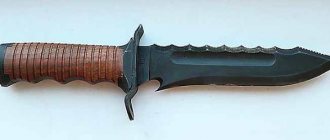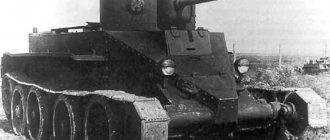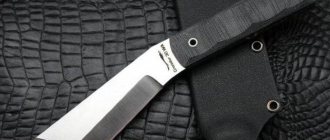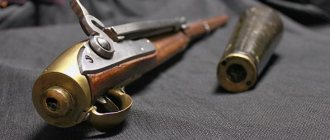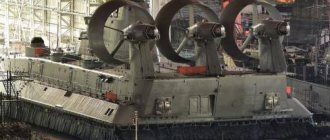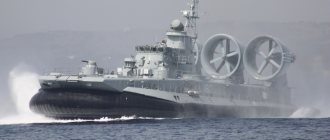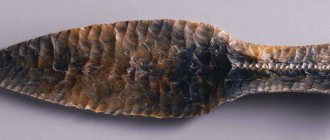The most ancient human weapon, with the possible exception of a stick and uncut stone, is a knife. The functionality and application of this weapon is limitless, from the function of chopping carrots in the kitchen, to a multi-optional Swiss folding knife. The combat knife has gone through a long evolution, from a hewn stone fragment to a modern combat knife, such as the “Katran” or “Bowie”. But its main purpose remains to cause injuries incompatible with life to the enemy.
It can also perform purely utilitarian tasks; with its blade you can open a can of canned food, cut sausage or gut a rabbit carcass. But the main task of the bevels and edges of the blade of a combat knife is to inflict deep puncture and cut wounds on the enemy; the shape of its blade is adjusted for this and the handle is adapted.
History of the combat knife
This weapon has been known since ancient times; most of the bladed weapons, one way or another, trace their history back to it. But knives began to acquire a familiar appearance with the development of metalworking.
The most famous example is the skramasax, a combat knife up to 70 cm long, with a blade up to half a meter. The blade width was 4...8 cm, with a thickness of 5...8 mm, sharpening was only one-sided.
It was used in battle as a left-handed weapon.
Due to their significant weight and sharp blade, they inflicted terrible stabbing wounds. But with an increase in the quality of the metal, its hardness and elasticity, the blades also received a second cutting edge, distinguishing themselves as subspecies of cutlasses and daggers.
In fact, at that time, several types of edged weapons could be distinguished:
- cleaver - a long and heavy blade with one-sided sharpening;
- dagger, piercing and cutting weapon with one or two-sided sharpening;
- stiletto, a type of dagger, a piercing bladed weapon, without a developed blade;
- combat throwing knives of various types;
- machete, a blade for household use at birth, a wide blade, without a pronounced edge for chopping blows.
The Russian combat knife also has a rich history. The Russian soldiers were armed with a Saxon type knife, but with a blade length of about 30 cm, worn on the hip; in addition, a boot knife was an obligatory element of equipment. Over time, they were changed to daggers.
In addition, in a multinational country, national types of weapons were also adopted. Thus, the Terek Cossack army had a Caucasian dagger as one of the elements of its uniform and weapons.
With the development of armor, knives changed, now they became an additional weapon, used to finish off the enemy, hence one of the common names “misericordia”, the blade of mercy.
This blade had a narrow blade that could push apart the rings of chainmail armor or pierce plate armor at the joint. In turn, from this dagger a branch of stilettos subsequently developed - narrow daggers designed for stabbing.
A further development of the combat dagger was the daga - a dagger for the left hand, it was used as an addition to the sword in fencing and often had a developed guard, with a basket covering the hand.
In addition, in order to grab and break or snatch the blade from the enemy’s hands, they often had retractable elements that gave the daga the appearance of a trident in a combat position.
As fire combat developed, edged weapons gradually became smaller and became more multifunctional. So in the line infantry, instead of swords, cutlasses and bebuts, artillery and sapper daggers with a curved blade began to appear.
This type of weapon was used not only as a weapon, but also as a tool. If necessary, they could loosen and dig the ground, or cut down a small tree.
It is also worth noting the national types of weapons, which subsequently became widespread due to their combat qualities:
- kukri, Nepalese combat knife, feature a reverse curve of the blade;
- sai is a stabbing dagger that came to Japan from Okinawa. Has a characteristic trident shape;
- Javanese kris with a wave-shaped blade;
- tanto are Japanese cutting knives with a characteristic angular blade shape.
With the development of firearms, baguettes also appeared - daggers with a cylindrical handle without a pommel, which were inserted into the bore after the shot.
This ancestor of the bayonet could also be used as a regular dagger when not attacking.
But its use was limited by the thin and uncomfortable handle. As a bayonet, the baguinet was also not very convenient, since it could slip out when the barrel was tilted down.
A little later, a more traditional bayonet appeared, attached to the barrel or stock of a rifle. Almost immediately, a variety of them appeared - bayonet knives. Their blade had a dagger shape, with a double-edged sharpening. The fastening device was located in the handle, adapted to be held by hand.
I think almost everyone knows an example of such a bladed weapon - a bayonet from an AK-74. Similar blades, only slightly longer and with a variety of handles and crosshairs, were used by almost all armies of the world in the period of the 18th-20th centuries.
Nowadays, a bayonet-knife is a necessary part of a long-barreled army firearm. Needless to say, even the SVD sniper rifle has mounts for fixing the bayonet to the barrel.
In addition to combined edged weapons, daggers also entered service with the army.
It is worth noting that at the beginning of the twentieth century, such daggers were more of a ceremonial and ceremonial weapon.
The Third Reich, for example, had a whole hierarchy of designations associated with daggers, so the dress uniform of an SS officer necessarily included a combat dagger of a unique shape.
The daggers of the postal services, various paramilitary forces and, of course, the Luftwaffe combat knife became very famous.
It is worth noting the Fairbairn-Sykes dagger, which was massively supplied to allied saboteurs and paratroopers during World War II.
Nowadays, daggers are used mainly by special-purpose units; in addition, it is necessary to distinguish several varieties of these weapons:
- army daggers;
- combined weapons (the USSR reconnaissance units received large numbers of NRs and LDCs);
- weapons for combat swimmers and paratroopers (the most prominent representative of this class is the NVU knife);
- survival knives.
These varieties have features and characteristics unique to them, which are usually contained in the shape and functionality of the blade, as well as in the material of the handle.
Varieties, general appearance and device
The knife consists of a blade, a cross and a handle. Contrary to popular belief, the knife does not have a guard, except, of course, for obsolete daggers - daggers.
The blade of a combat knife is usually made of hard and elastic steel. To avoid corrosion, the steel is polished and coated with an anti-reflective coating, this will guarantee that the blade will not reflect light, unmasking its owner.
The blade is most often combined, with one-and-a-half or two-sided sharpening and a serrated saw at the butt. Single-sided sharpening of the blade on a combat knife is rare. This is primarily due to its task.
The military combat knife is designed to kill people.
Therefore, its blade must have dimensions appropriate for the task. One-and-a-half or two-sided sharpening is needed so that when fencing and cutting blows you do not select the desired side, but simply hit.
A serrated or wave-shaped saw and hooks at the butt of the blade are needed to cut ropes and nets if necessary. This is especially true for combat swimmers and paratroopers. It should be noted that such a saw can cut through a small tree, although this will take quite a lot of time and effort.
The handle of a combat knife should be comfortable to hold and have stops or a crosspiece, this is necessary so that when struck, the hand does not slip onto the blade. The butt plate of the handle most often has a metal frame; this is a purely utilitarian device for delivering crushing blows.
The purpose of the knives also dictates their design. The daggers of combat swimmers and paratroopers, as a rule, have a serrated saw for cutting nets or lines that become entangled when the parachute opens.
In addition, in order to increase functionality, the sheath of such knives can be used to accommodate the necessary tools for sharpening a blade or a portable emergency supply.
Also, often the reserve can be placed in the hollow handle of the blade.
The handle material is selected based on the operating conditions. Currently, the most common materials are:
- polymers, such as elastane or kraton, are usually used for swimmers;
- wood, handles made from it “warm” your hands in the cold and do not slip in a wet hand, but at the same time this material is extremely fragile and quickly breaks down in a humid climate;
- inlaid leather, consists of rings of thick leather mounted on the shank of the blade, such material does not slip in the hand, but absorbs fat and grease, and is also afraid of water;
- inlaid from birch bark, the same as wood.
Thus, of all the material options, polymers are the most versatile option. Their advantages are durability, non-slip coating, resistance to water, fats and oils.
But, these materials are characterized by unstable behavior in the cold, which somewhat reduces their performance characteristics. It is necessary to note the combined samples of these weapons:
- legendary ballistic knives described in the book by Rezun-Suvorov;
- shooting, the most famous of which is the NRS-2;
- instruments commonly used by pilots and astronauts.
Survival knives, although not fully combat knives, nevertheless serve the same purposes. Unlike skinning, hunting and tactical options.
Description
The weapon looked standard:
- same type of straight blade “clip-point”;
- pike;
- simple wooden handle without protective elements;
- in order to securely hold the handle in the hand, a small notch or protrusion was cut out on it (this part was called a “knot”);
- the blade was additionally equipped with a metal ring, which was intended to strengthen the handle;
- the dimensions were indicated by numbers on the surface of the handle.
, located in the village of Vacha, Nizhny Novgorod region, produced Finnish products with forged handles. U8 grade steel was used for the blade.
The factory mark was always placed on the back of the handle. The blade and handle were molded together in one way. This means that the shank was walking between the parts. The hollow space was filled with lead so that the blade was not removable.
Finks produced 3 sizes:
- large blade – 16.5 centimeters;
- average blade – 14 centimeters;
- small blade – 11 centimeters.
Combat knives of Russia and the world
The Soviet army was content with mass-produced bayonets from machine guns, and rare combat daggers of the GRU special forces - NR-2, NRS-2 and NSU.
But in the 90s, research on this topic began and the army was filled with combat knives of various kinds.
It got to the point that each department and unit had its own model of a combat dagger. And this is not counting the Soviet models in service.
"Katran"
First of all, this is, of course, “Katran”. A knife designed to arm the Russian Marine Corps, the FSB and combat swimmers. Depending on the design, it may have a different design of the handle. But I think that if used by troops, the most convenient option would be the craton.
The blade is 180 mm long, has an anti-reflective coating, one-and-a-half sharpening, on the top there is a wave saw, and on the bottom at the butt there is a serrated saw for cutting ropes. The wave saw is a requirement of swimmers, it is designed to, if necessary, cut the steel wire reinforced tube of a diving hose.
Initially, it was planned to use the Katran with a sheath as a wire cutter, so the prototype blade had a hook for fixing it, but this decision was later abandoned and the hook was removed.
The handle contains a sealed capsule for the NAZ (emergency reserve) and a notch for more comfortable holding. The crosshair is developed, with a rest for the fingers.
Civilian samples do not have a wave-shaped saw on the top; it was replaced by an imitation notch; in addition, some civilian samples were designed with a screwdriver instead of a blade tip.
The sheath was made in several versions, including one made of dark polymer with a metal leaf spring that prevented the blade from falling out.
After the production of about 3,000 copies, production of the combat model of the knife was discontinued, because during patrols in the Indian Ocean, the Marines noticed that the steel was susceptible to corrosion without care; the anti-reflective coating of black chrome did not protect against it.
"Storm"
The “Storm” knife was developed in the same theme; unlike the “Katran”, this weapon is intended only for combat. There is no saw on its blade, only a hook for use as a wire cutter. Blade length 170 mm.
The handle has a developed cross and is made of kraton or elastane. The part is made with stacked wooden and leather handles.
Leather sheath, for attaching to a waist belt. The combat model did not enter mass production.
"Cobra"
A combat knife from Zlatoust, made by order of the Ministry of Internal Affairs of the Russian Federation for arming SOBR soldiers.
The blade is leaf-shaped, chrome-plated, the handle is leather, inlaid, or elastane.
The crosshair is metal, the lugs are curved towards the blade, the butt plate is made of white metal. The length is only 160 mm. Leather sheath, with belt fastening.
The combat knives of the special forces of the Ministry of Internal Affairs were received quite well, but they were not produced in significant quantities.
Extrema Ratio Col Moschin
A combat knife produced by Extrema Ratio, adopted by the 9th Parachute Regiment of the Italian Army.
The handle is made of polymer material, has a developed cross with massive lugs.
The blade is sharpened on both sides and coated with a black anti-reflective coating. Blade length 160 mm.
The shape of the blade is asymmetrical, with a lowered tip and sharp transitions. When attacking, this blade shape is preferable for inflicting cut wounds with jagged edges.
On the butt of the lower part there is a serrator with teeth of different heights. The sheath is polymer, with a universal fastening.
"Ka-Bar"
The famous US Marine Corps knife. The blade is single-sided sharpened, 180 mm long, the handle with a small cross is made of leather. The butt plate is a massive metal cap.
The scabbard is plastic or leather, depending on the design and type, the mount is most often universal.
Caring for a rarity
For a knife to serve faithfully, it is necessary to properly care for it.
Main care rules:
- It is highly not recommended to store knives in a leather case, as the protective coating contains substances that cause corrosion of steel.
- A wooden or plastic handle must be lubricated with certain oils to prevent abrasions and cracks from appearing on them.
- Leather handles must be treated with special impregnations.
- If pitting appears on the blade, you need to go over the metal surface with sandpaper.
Law
The laws of the Russian Federation prohibit the internal circulation of military edged weapons. Making such weapons at home risks criminal prosecution. And what lies on the shelves of hunting stores are usually civilian modifications of famous samples, which are inferior to the prototype in all respects.
In addition, there are a number of simulators of combat samples available for free sale, made according to the skinning standard. These knives do not require a license, but at the same time they differ in their characteristics from their combat prototypes.
When purchasing such a weapon, do not forget to get a certificate from the seller stating that this knife is a skinning knife and is not a bladed weapon.
Bottom line
A sapper or Finnish knife is not only a weapon for hand-to-hand combat, but also a necessary thing in the household. Thanks to the unique properties of the material, the product can be used for household needs.
Previous
Ancient HOG Georgian knife - the pride and dignity of a highlander
Next
National knivesNorwegian hunting knife: 7 cool Helle models

